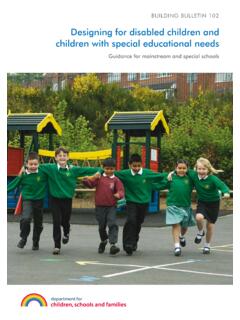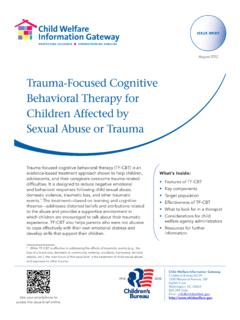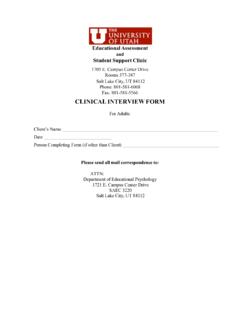Transcription of TIME-OUT INTERVENTIONS AND STRATEGIES: A BRIEF …
1 INTERNATIONAL JOURNAL OF SPECIAL EDUCATION Vol 21 2006 22 TIME-OUT INTERVENTIONS AND strategies : A BRIEF REVIEW AND RECOMMENDATIONS Tera L. Wolf T. F. McLaughlin and Randy Lee Williams Gonzaga University The present paper reviews the literature regarding TIME-OUT INTERVENTIONS employed in home, school , and clinical settings. Characteristics examined include types of TIME-OUT , populations and settings, legal implications, and research implications.
2 Policy recommendations for teachers, parents, and clinicians regarding TIME-OUT INTERVENTIONS are included. The use of TIME-OUT as an acceptable therapeutic procedure has gained wide acceptance in schools, clinics, and hospitals. TIME-OUT is a behavior change technique used to decrease the frequency of a target behavior, and is most effective for behaviors that are maintained either by attention or tangible reinforcers and if there is high discriminability between the TIME-OUT environment and the reinforcing environment, often referred to as time -in (Turner & Watson, 1999).
3 The TIME-OUT technique involves placing a child in an environment limited in sensory stimulation contingent upon the emission of deviant behavior (Webster, 1976). TIME-OUT has been effective in reducing such behaviors as tantrums, inappropriate social behaviors, yelling, aggression, time spent out-of-seat, and inappropriate verbalizations (Alberto, Heflin, & Andrews, 2002; Mortimer, Adamsky, & McLaughlin, 1998). TIME-OUT is a complicated and intricate intervention, involving far more than simply withdrawing an individual from ongoing activities and then returning him or her after a predetermined period of time .
4 Effective timeout procedures are likely to vary a great deal, depending upon such factors as who is administering the intervention, the individual involved, and the setting (Harris, 1985). TIME-OUT is frequently misunderstood and even incorrectly defined by both professionals and lay persons (Harris, 1985). This may be due to such factors as changes in the conceptualization of TIME-OUT over time , the variety of ways to implement TIME-OUT , the multiple definitions which exist in the literature, occasional paradoxical effects, and difficulties in differentiating between TIME-OUT and response cost or extinction (Alberto et al.)
5 , 2002). As the use of TIME-OUT in both basic research and applied settings increased, definitions of TIME-OUT changed and began to focus on contingent withdrawal from the opportunity to obtain reinforcement and a meaningful discrepancy between the time -in and TIME-OUT environments (Harris, 1985). Few behavioral management techniques have generated as much controversy as isolation timeout. Educators and other professionals have used timeout procedures to modify a broad range of maladaptive behaviors in children and youth.
6 Timeout is a somewhat aversive procedure on the continuum of behavior-reduction techniques, which also include environmental modification, differential reinforcement, response cost, overcorrection, aversive conditioning, and corporal punishment (Costenbader & Reading-Brown, 1995). The continuum of ascending restrictiveness involved with using TIME-OUT includes such procedures as planned ignoring, during which social attention is removed from the individual; INTERNATIONAL JOURNAL OF SPECIAL EDUCATION Vol 21 2006 23contingent observation, where a student watches from the periphery but may not participate in group activities during the timeout period.
7 Exclusion timeout, when a student is removed from the reinforcing environment but may sit facing the corner of the room; and isolation or seclusion timeout, the most restrictive of these INTERVENTIONS , in which the student is removed from the classroom and stays alone in a barren room for a specified period of time . Types of TIME-OUT Harris (1985) outlined three major types of TIME-OUT : exclusionary, non-exclusionary, and isolation TIME-OUT . Of these three, the first two types seem best suited for classroom use because the child does not need to be removed from the room (in accordance with the policy of least restrictive intervention).
8 Exclusionary. Exclusionary TIME-OUT involves removing the child from the reinforcing situation but not from the room or area of activity ( , playground, gym). When a child displays the inappropriate target behavior, he or she is immediately removed from the activity for a period of time . Examples of this type of TIME-OUT are sending a child to a corner of the room or a chair positioned away from the ongoing activity. The child is not allowed to view or be involved in any activity for a specified amount of time (Harris, 1985; Mace & Heller, 1990; Mortimer et al.)
9 , 1998). Nonexclusinoary. Nonexclusion TIME-OUT is similar to exclusion TIME-OUT in that the child is removed from the reinforcing situation for a certain amount of time but may still observe the ongoing activity of the class (Harris, 1985). Nonexclusinoary TIME-OUT has been further divided into three subcategories: contingent observation, removal of stimulus conditions, and ignoring (Costenbader & Reading-Brown, 1995; Harris, 1985). Harris (1985) defines the first subcategory, contingent observation, as a procedure wherin the individual is required to sit on the periphery of the ongoing activity and observe the appropriate behaviors of her or his peers for a BRIEF period of time ( ).
10 This type of TIME-OUT would be ideal during some activity such as recess or a structured group academic task in which the child can observe appropriate peer behaviors and see those behaviors being reinforced. To make contingent observation TIME-OUT most effective, the teacher must reinforce appropriate behaviors and the resulting reinforcement (Turner & Watson, 1999). After TIME-OUT is over, the teacher must then monitor the child to reinforce the first appropriate behavior demonstrated by the target child to ensure a rich time -in environment and to increase the discriminability between TIME-OUT and the classroom (Marlow, Tingstrom, Olmi, & Edwards, 1997).















